Maybe it’s the telltale click-clack as your dog moseys across the kitchen floor. Or the unmistakable and often painful raking sensation when she jumps up to greet you. Or maybe it’s when you’re lounging together on the couch and you realize your dog’s nails have grown so long, you’re not sure if you should trim them or see what they’d look like if painted a sizzling shade of fire-engine red!
Whatever prompts you to notice that your dog’s nails need attention, good for you. Nail care is important, and it’s often overlooked by owners who either aren’t sure how to do it, are afraid to trim nails themselves, or can’t quite get their dogs to go along with the program. If this describes you, we can show you how to do it most easily and how to get your dog to not just cooperate, but to willingly volunteer for a trim.
GRIND AWAY
There are many benefits of do-it-yourself dog mani-pedis, especially when you take the time to teach your dog to cooperate during the procedure by slowly and carefully desensitizing and counter-conditioning first. (See “A Counter-Conditioning Protocol for Nail Trimming” on page 5.) Some of the DYI benefits include:
• Improved health. Walking on long nails can affect how the dog moves and potentially contribute to the development of orthopedic problems, such as arthritis, later in life.
• Decreased stress. Teaching your dog to calmly tolerate a nail trim prevents stress and, potentially, fear-based aggression.
• Increased safety. The dog is less likely to be injured as a result of active resistance or panic-induced flailing, and you (or your vet or groomer) are less likely to sustain a bite.
• Body awareness. Time spent trimming nails is also the perfect opportunity to familiarize yourself with your dog’s physical topography. Regularly getting your hands on your dog – beyond basic petting – is a great way to quickly recognize changes that could indicate health problems.
• Financial benefits. The cost of professional nail trimming adds up over time!
There are two main ways to shorten nails: clipping with either a guillotine-style or a scissor-type clipper and grinding with a rotary tool such as a Dremel or a similar product designed specifically for grinding dog nails.
Between the two methods, many groomers (and I) prefer using a rotary nail-grinding tool, even though many dogs need to be desensitized to the sound and the vibrating sensation. The biggest advantage of using a nail grinder over clippers is that with clippers, if you cut off too much – either because you misjudged how much to cut, or the dog wiggled just as you squeezed the handle – you’re more likely to “quick” the nail by mistake. (“Quicking” a nail happens when you cut into the blood supply of the nail. It can be painful and, as a result of the yelp and reflexive action that the pain elicited from the dog, traumatizing for both the dog and the person doing the nails.)
In contrast, grinding the nail involves high-speed filing where the excess growth is ground down incrementally but quickly, as long as the tool is in contact with the nail. You can “quick” a nail by going too short with a grinder, too, but in our experience, you have to work harder to do so.
The other advantage of grinding vs. clipping is how the high-speed filing makes it easy to round off the tip of the nail, whereas clipping often leaves sharp edges. If your dog tends to paw at people for attention, this can be problematic until the nails naturally wear down into a more rounded shape.
We’ve published a number of articles in the past about clipping a dog’s nails; what follows here is all about using a grinder instead.
POSITIONED FOR SUCCESS
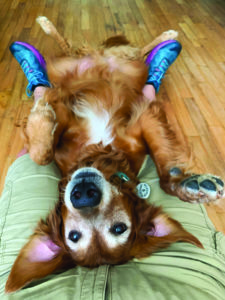
It takes a little practice to figure out what position is most comfortable for you and your dog during the nail trim. Both of you on the floor? Him on the couch and you on the floor? On a grooming table? Some people find it easiest to trim the dog’s nails when he is laying flat on his side.
I find it easiest to sit on the floor, legs outstretched, with my dog on his back and cradled between my legs. I find this allows for the most comfortable angle of approach to grind the nails, and especially for rounding the edges, as I like to round up from the bottom of the nail. I teach and build value for this position early in my dogs’ lives, and we use it often – it’s an opportunity for quiet massage and “together time” – not just something we do when it’s time to trim nails.
No matter what position you use, don’t forget to first build a positive association with simply being in that position and having his paws handled before you add any of the steps that involve trimming nails. I feel strongly that all dogs should be taught to accept all the different behavioral pieces of a nail trim regardless of whether you will do nails yourself or if you plan to send the dog to a vet or groomer for routine trims.
It’s wise to “assume the position” often – for praise, treats, and calm petting – to help keep your dog from learning that your request for that particular position always accompanies nail trimming, in which case you may find your dog becomes reluctant to cooperate.
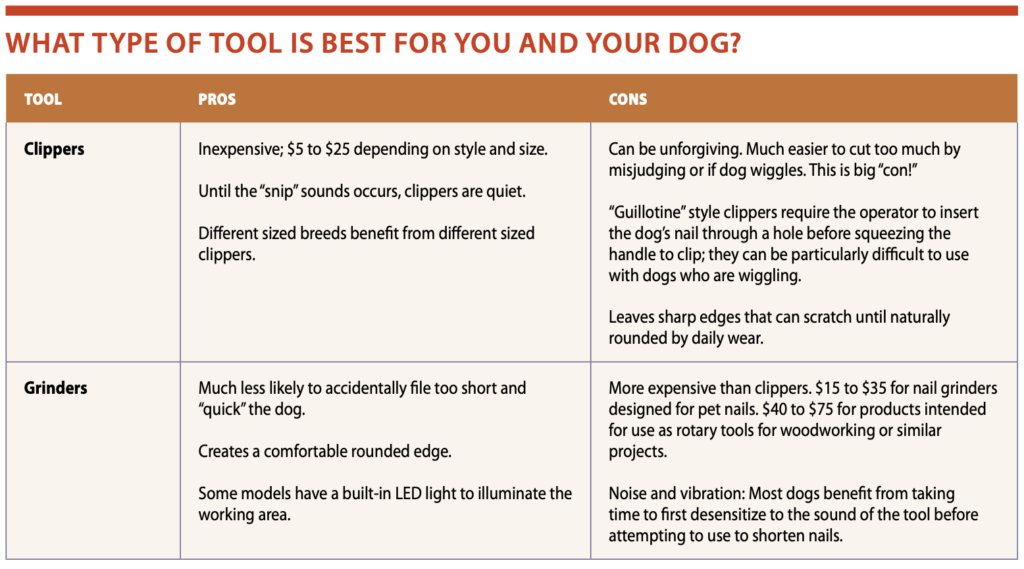
READY TO GRIND
The goal of nail trimming is to shorten the dog’s nails so that they don’t quite touch the ground when she is standing on level ground; she should be able to walk across the kitchen floor without a tap, tap, tapping sound. Nails that touch the ground will push the toes out of their natural position as the dog stands and moves; the longer the nails, the more displacement the toes will experience.
Remember, the innermost core of the nail consists of a vein and nerve, usually referred to as the “quick.” The longer the nail, the farther toward the tip of the nail the quick will extend. If your dog’s nails are far too long, it will take a lot of sessions of removing tiny bits of nail at a time to gradually return them to a healthy length without cutting into the quick, hurting the dog, and causing the vein to bleed (called “quicking” the nail).
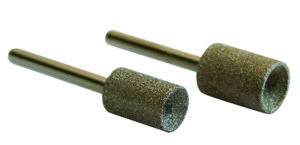
Fortunately, taking tiny bits off at a time is exactly what rotary grinders are best at! Frequently removing the excess nail a millimeter at a time will help the “quick” recede back toward the base of the nail. For very long nails, see if you can fit a few minutes of nail grinding once a week. It might take months of this to get the nails to a short and strong condition, but if you stick with it, your dog’s feet and legs will be much healthier for it. Once your dog’s nails have reached an appropriate length, just one or two short sessions of grinding each month should maintain them.
A few final tips:
* Don’t grind on any one nail for more than a second or two, as the friction creates heat, causing a burning sensation. Touch the grinder to the nail for one or two seconds and pull it away – a grind-release, grind-release pattern.
* To maintain the effectiveness of the grinder, be sure to replace the sandpaper-like sanding band once it’s worn. Replacement bands are inexpensive – about $6 for a package of 6 – and can be purchased through many online pet-supply stores.
* Using a diamond bit (instead of sanding bands) helps reduce the noise and vibration of grinding. These bits are more expensive (anywhere from $20 to $20) but they last a long time.
With a little product research and some training and practice, you, too might soon find yourself a member of the rotary club.
Stephanie Colman is a writer and dog trainer in Southern California. She works in the puppy department at Guide Dogs of America, helping to recruit and manage volunteer puppy raisers.
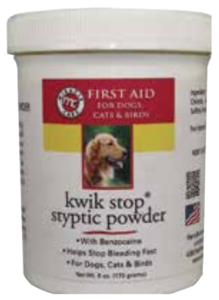
Whichever tool you use to trim nails, don’t get started without having some styptic powder on hand.
Styptic powder is used to quickly stop any bleeding that will occur if you accidentally cut into the nail’s blood supply. It’s an anti-hemorrhagic agent that works by constricting tissue to seal injured blood vessels.
Failing to have the powder nearby when you start nails is a great way to simulate a crime scene; if you have a “whoops!” moment when trimming your dog’s nails and have to go into the other room to get the powder, you can be sure your dog will leave a bloody trail – either following you or trying to run and hide from you!
Styptic powder is sold in a variety of containers with various applicators that are supposed to make it easier to get onto a cut nail quickly. Most commonly, however, it comes in a small jar. Some people tap some of the powder into the palm of their hand and then press the cut nail into the powder in their hand. I like to keep a little dish of water nearby so I can wet my finger without needing to lick it, especially during these pandemic times, where I’m being extra mindful of keeping my hands off my face in general. I coat my wet finger with a generous layer of styptic powder and press the powder directly onto the affected nail tip. I give a little tap to help pack the quick with powder.
Reapply as needed if the nail continues to bleed through the first layer of powder. If needed, you can temporarily occupy the dog with a favorite chew bone to prevent him from smelling and then licking the nail, re-starting the bleeding.
No styptic powder? In a pinch, cornstarch also works.
If the bleeding hasn’t stopped within 20-30 minutes, contact your vet, as that can be a possible sign of clotting issues.


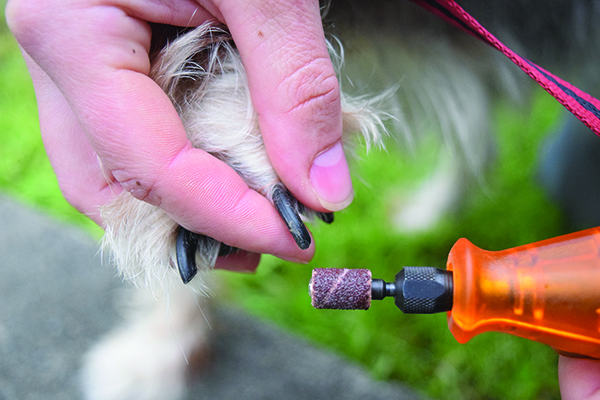




Good advice and recommendations. One other issue is that groomers may not sterilize their trimmers or grinding drums between clients. Our puppy suffered a severe infection to one of her nail quicks and lost the nail. It eventually grew back. After that experience, I learned to trim her nails myself, sterilizing the trimmers between use. Then I started grinding and no more issues.
So I’ve been using a Dremel for years on my three dogs; once a week. I’d love to invest in the Diamond Grinding Tips but can’t seem to find them anywhere. Any ideas or links? Thanks!
You should be able to find them on Amazon with a search for “diamond bit for dog nails”. I purchased the “ShearsDirect Diamond Wheel 1/2″ Rotary Kit” there for my dog’s Dremel grinder several years ago and it works wonderfully.
Nice article. Have done our three Mals this way (Dremel), for many years. I find that the toughest part is trimming the dew claws. Being that the dremel only rotates in I believe a CCW direction, when I get over the the left front foot, I have to position myself and the dremel at an awkward angle, in order to dremel the nail in the correct direction. It would be nice to have a dremel that had a shaft rotation that you could change.
I’ve been trimming dog nails for over 50 years. My own dogs, as a groomer and vet tech, in Humane Society work and for the last 17 years in my shop where we offer drop-in nail trims for $5. I think both cutting and grinding have their place, and my ideal is to use both. But I think the author underestimates the hazards of the grinders. It’s true that they are less likely to quick the nail. But long hair on feet and legs, or long hair on the groomer, present opportunities for much more serious injuries and trauma, if the whirling grinder catches up some hair. I’ve seen this with inexperienced users and even experienced groomers unfamiliar with the method. Ideally, desensitizing a dog to both tools allows for fast and safe cutting and a very fast finish-rounding of the claw. Working on dogs whose claws have gotten so overgrown that they cut back into the pad and only a scissor-type clipper will suffice, or nails so long and thick that it would take 10 minutes per nail to restore normal foot function, clipping is safest – even with struggling, wiggly dogs. The error most owners make is not securely holding the toe with one hand and not clipping until the toe is still and stable. For sound sensitive dogs, I’ve found that some cotton in the ears works wonders. Think of how the dentist’s drill sound affects you! This is a source of discomfort, even pain, for some dogs – not a matter that can be counter-conditioned away. But it can be eliminated by buffering the sound with cotton.
100%!
Could add to list of Dremel pitfalls (I do use both) but will instead pitch for taking advantage of groomers’ drop-in services.
No shame in recruiting support for attaining good nail condition and paw neutrality. And, TIP groomers hard! Canine nail care is essential preventive medical treatment. For me, it was the most efficient way of acclimating my dog to strangers handling her feet.
THANK YOU FOR SUCH CARING & WONDERFUL IDEAS🐾
I buy my grinding tool for my dog at cvs …
How did you condition your dog to recline in your lap? Do you have that information in an article somewhere? I always have a problem figuring out how to position my hands and tools with relationship to my dog’s feet. That looks like a position that puts everything in the right place.
Thanks,
I found the AT01-PGK Pet Grooming Nail Guard for Dremel was only $17.99 on Amazon and not the $33 quoted. If anyone just wants to get the guard. What I have found with these plastic guards is that you can’t get a tiny dog’s nails anywhere close to the grinding wheel. I have had the long hair in the wheel get caught when I removed the guard so I could reach the nail! Awful moments. From the pic I couldn’t tell if I would have the same problem with the Dremel guard of not reaching the nail. I do like the Casfuy protector as it allows the nail to easily reach the grinder and protect any long hair. I don’t have this newer model. I purchased one about a year ago that had only 1 speed. It does not hold a charge long enough to trim one dog so I was unhappy with it.
I have never thought about which one is better, grinders or clippers before and now I know that. Thanks!
Professional above, Laurie Raymond said grinders are dangerous with long haired dogs, like my 6 pound tiny long haired girl, will stick with clippers. I started with sand paper actually. My dog is so scared, being a puppy mill rescue, obviously she had been abused or traumatized while being groomed when rescued at spca . Grinders May be best for short haired larger dogs .
I prefer a coarse sanding drum to the fine ones. A coarse grit grinds the claws more quickly, building up far less heat, and they leave the claws more than smooth enough.